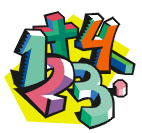Adding to ten

Complete the following equations that add to ten.
|
|
Y5 (05/05) |
|
|
a) |
5 |
very easy |
These results are based on a trial set of 149 Y5 students.
Students could solve these equations in a number of ways - by counting on, counting back (Stage 4: Advanced counting - strategy, from The Number framework, book 1, 2004) or by simply recalling them as addition and subtraction facts (addition facts to 10 is at Stage 4: Advanced counting - knowledge).
Once students are comfortable and confident with equations that total to ten and are calculating without materials or pictures, get them to solve similar problems that total to twenty. Give students problems similar to those in part b) but with two missing numbers.i.e., 4 +  +
+  = 10
= 10
Encourage students to explore the relationships between the numbers by getting them to find all the possible combinations of numbers that would correctly solve the problem (including 0).
For a similar level 2 ARB resource that includes adding to ten and adding to twenty refer to Ten and Twenty.
For more information about basic facts, see the Basic facts concept map.

